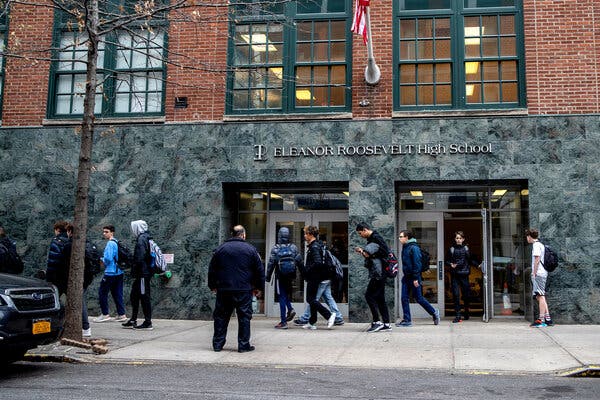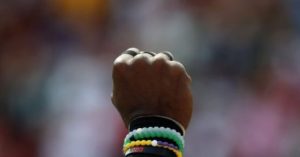On paper, Tiffani Torres looked like a strong candidate for one of New York City’s highest-performing, most selective public high schools. She had high test scores and excellent grades. “I was a good fit for what the school was looking for,” Tiffani said.
But when Tiffani was rejected by her dream school, Eleanor Roosevelt High School on the Upper East Side of Manhattan, she didn’t realize she never had much of a chance in the first place.
That’s because Tiffani lived in Brownsville, a mostly low-income, Black and Hispanic neighborhood in the center of Brooklyn.
“At the time,” she said, “I didn’t understand what my ZIP code had to do with anything.”
As New York City races to reopen school buildings physically next month, it is clear that the pandemic has exacerbated the gap between the wealthy and everyone else.
But the unusual admissions carve-out available to children in some of the city’s richest neighborhoods shows just how profoundly inequality was baked into the nation’s largest public school system, long before the virus hit.
Eleanor Roosevelt, on East 76th Street, can fill most of its seats with students who already live in New York City’s School District 2 before considering students from other parts the city.
The district weaves a conspicuous path through Manhattan’s richest neighborhoods — from the Upper East Side to the West Village, SoHo and Tribeca. But the boundary lines exclude nearby neighborhoods that have large concentrations of public housing and low-income students, including East Harlem, the Lower East Side and Chinatown.
The lines were drawn in the late 1960s, decades before parts of the district became wealthy, but have remained largely untouched for the last half-century.
Unlike a vast majority of high schools in New York City, Eleanor Roosevelt and five other high schools in District 2, which are some of the city’s best, give high-performing students who live in the district first dibs.
Children in most of the city’s poorest neighborhoods have no such perk. Instead, they generally compete with tens of thousands of students across New York for high school seats.
As mass protests against institutionalized racism have forced liberal New York City to reckon with its entrenched inequality, the segregated nature of its school system — along with District 2’s lopsided demographics and rare admissions exception — has once again come into focus.
Several hundred teachers in the district recently signed a letter calling on the city to overhaul its competitive middle school admissions process and replace it with a lottery system modeled on a new effort to integrate middle schools in a largely upper-middle-class area of Brooklyn.
“The practice of screening and separating our students does not speak to our values as teachers,” the educators wrote.
Some experts say getting rid of the priority system in District 2 high schools is an obvious next step in the protracted battle for genuine integration.
“I don’t understand it, I’ve never understood it,” Amy Stuart Wells, a professor at Columbia University’s Teachers College, said of the exception. “It’s so unfair.”
The District 2 priority was established in the 1990s as part of an effort to keep the neighborhood’s middle-class parents invested in their local district through high school, even as schools in much of the rest of the city struggled. But schools across the city have improved in the decades since, leaving some to wonder why an admissions exception that benefits a small but influential number of families has been left untouched.
Mayor Bill de Blasio has spent the last two years pushing to overhaul admissions for the city’s eight so-called specialized high schools — the only ones in the city whose admissions are controlled by the State Legislature.
Though the mayor has the unilateral power to change or eliminate the District 2 priority, he has been noncommittal on the issue.
“We are taking a hard look at our admissions policies to ensure we are serving every community equitably,” Jane Meyer, a spokeswoman for the mayor, said this spring.
While specialized high schools like Stuyvesant and Bronx Science have mostly low-income Asian-American students, District 2’s selective high schools are largely white and middle- or upper-middle class.
That has prompted several politicians who represent parts of District 2 — including the City Council speaker and mayoral candidate Corey Johnson — to support changing the priority system.
Because of district boundary lines that exclude neighborhoods with large populations of Black and Hispanic children, Eleanor Roosevelt is one of the whitest public high schools in New York City.
Last year, two-thirds of Eleanor Roosevelt’s students were white; only 3 percent of the student body was Black. The school boasts a perfect graduation rate — almost unheard-of for a public high school in the city — and an active parent-teacher association that requested $1,000 donations per child in 2018 for a $200,000 operating budget. That money went to the school’s college admissions office, and to athletics and after-school programs.
About 20 percent of its students lived at or below the poverty line, a seemingly high number that is actually significantly below the city average; about three-quarters of New York’s public school students are considered poor.
In an attempt to bolster diversity, starting this year Eleanor Roosevelt will for the first time reserve about a third of its freshman seats for low-income students who live in in District 2 — or, in the unlikely event that there are not enough local applicants, in the borough of Manhattan.
The school’s few Black and Hispanic students have sometimes been the targets of bullying. Last year, a Black student said she was handed a tampon on which a racist epithet had been scrawled.
An Instagram page created this summer by Black and Hispanic alumni of the school features dozens of posts recounting incidents of racism and discrimination.
Christy Atangana, who graduated from Eleanor Roosevelt in 2018, said that she could count the number of other Black students who had been there on two hands and that she had only one Black teacher.
She called the district preference a “disservice” to children who could benefit from more diversity in their schools. “When you’re just with the same people all the time, not much development takes place,” she said.
That perspective has left Tiffani Torres, now 17, relieved that she did not get into Eleanor Roosevelt. Five years after she applied to the school, Tiffani is now an integration activist who recently graduated from Pace High School — one of the few District 2 high schools without a geographic preference or academic admissions requirements.
“There was a systemic issue that was preventing me from accessing a school advertised as one of the best in the city,” she said, calling the rejection by Eleanor Roosevelt “kind of like my first introduction to the inequity of our school system.”
Eleanor Roosevelt was created in 2002 after Upper East Side parents rallied their elected officials to create an excellent neighborhood high school. Some of those families were actually disappointed that the school settled on a district preference, rather than an even smaller zone exclusively for Upper East Siders.
Maud Maron, the president of District 2’s elected parent council, said she wanted to protect the District 2 priority, and she argued that parents in other areas should follow her district’s lead.
“That kind of advocacy and collaboration should be complimented, celebrated, replicated, not attacked,” she said, adding that she wants the remaining District 2 high schools that do not use the geographic admissions preference to consider adopting it.
The other District 2 high schools that limit enrollment based on geography share Eleanor Roosevelt’s impressive academic results — and its anomalous demographics.
The Lab School for Collaborative Studies in Chelsea, which filled 82 percent of its seats with District 2 students last fall, was 58 percent white and 4 percent Black last year.
Baruch College Campus High School, near Madison Square Park, is mostly white and Asian, with high graduation and college-readiness rates, and low Black enrollment. It filled 81 percent of its seats with District 2 students last year. Both of those schools recently adopted admissions set-asides to increase diversity.
New York is unique among large school districts for allowing students to apply to high schools anywhere in the city. Its famously byzantine admissions process forces parents to navigate a maze of requirements for the top schools, which can include test scores, grades, essays, interviews and attendance records. But until 2003, most city school students simply attended high schools near where they lived.
That changed when Mayor Michael R. Bloomberg scrapped traditional high school zones in an attempt to democratize admissions and open the best schools to the best students.
But some geographic preferences were left intact.
Of more than 400 public high schools in New York City, only about three dozen outside of District 2 give local students preferential admission. Those tend to be in less affluent neighborhoods, and they are generally not as selective or high-performing as District 2’s priority high schools.
But no other district in New York has the concentration of high schools set aside for locals that District 2 does.
While high-ranking education officials in New York said they were aware of the inequity — and no politicians who represent District 2 would explicitly defend the high school admissions policy — there was little consensus on how to make the system more fair without alienating local families.
Mr. Johnson, the council speaker who represents parts of the district and who is considering a run for mayor, said the city should consider changes while exploring other integration measures. Gale Brewer, the Manhattan borough president, said she thought the city should focus on creating high-quality high schools in other districts rather than eliminating the preference.
Richard A. Carranza, the schools chancellor, has signaled his willingness to eliminate it. Mr. de Blasio, who manages the school system and has been much more wary of integration policies than the chancellor, has not yet signed off.
Mr. de Blasio’s own arguments about the need to eliminate the entrance exam for the eight specialized high schools would appear to support a case against the District 2 priority.
When he announced his plan to overhaul specialized school admissions at a triumphant news conference in the summer of 2018, he lamented the fact that “ZIP code is limiting destiny right now in New York City.”
Since his specialized school plan failed in the State Legislature last summer, Mr. de Blasio has faced renewed pressure to make changes in at least some of the roughly 1,800 schools he does control.
Last August, a panel he convened to study integration policies recommended that the city overhaul its gifted and talented program and scrap geographic zones for high school admissions, including District 2’s. Mr. de Blasio quickly distanced himself from the proposal.
Some District 2 parents said that they believed the admissions set-aside was unfair but that the city should focus on overhauling admissions across the system.
“If we’re just going to pull away District 2 priority, that’s fine, I don’t really care, but I don’t think that’s going to get us any closer to integration,” said Robin Broshi, an elected parent leader in District 2. “If you’re getting rid of it, what else are you doing?”



















